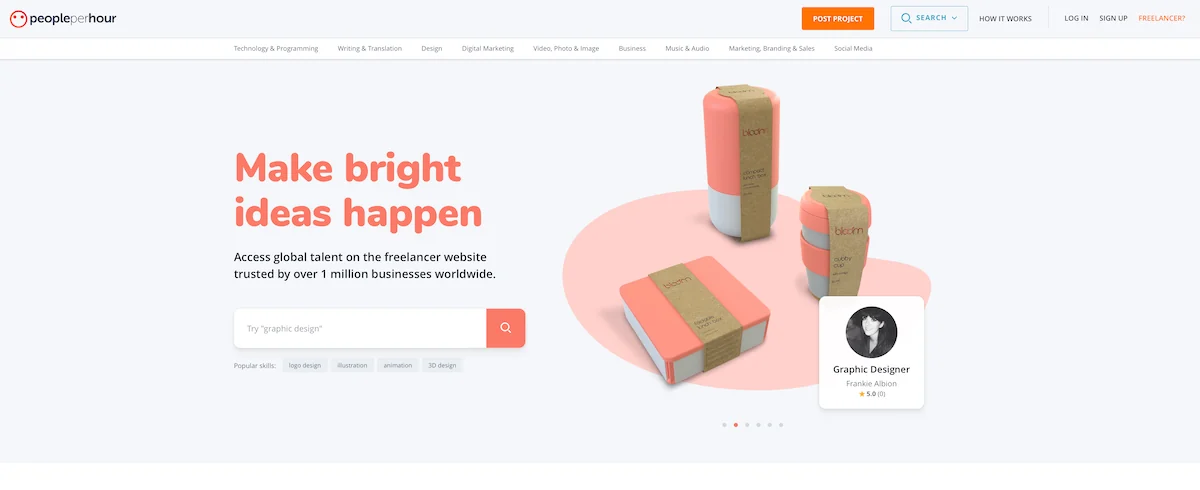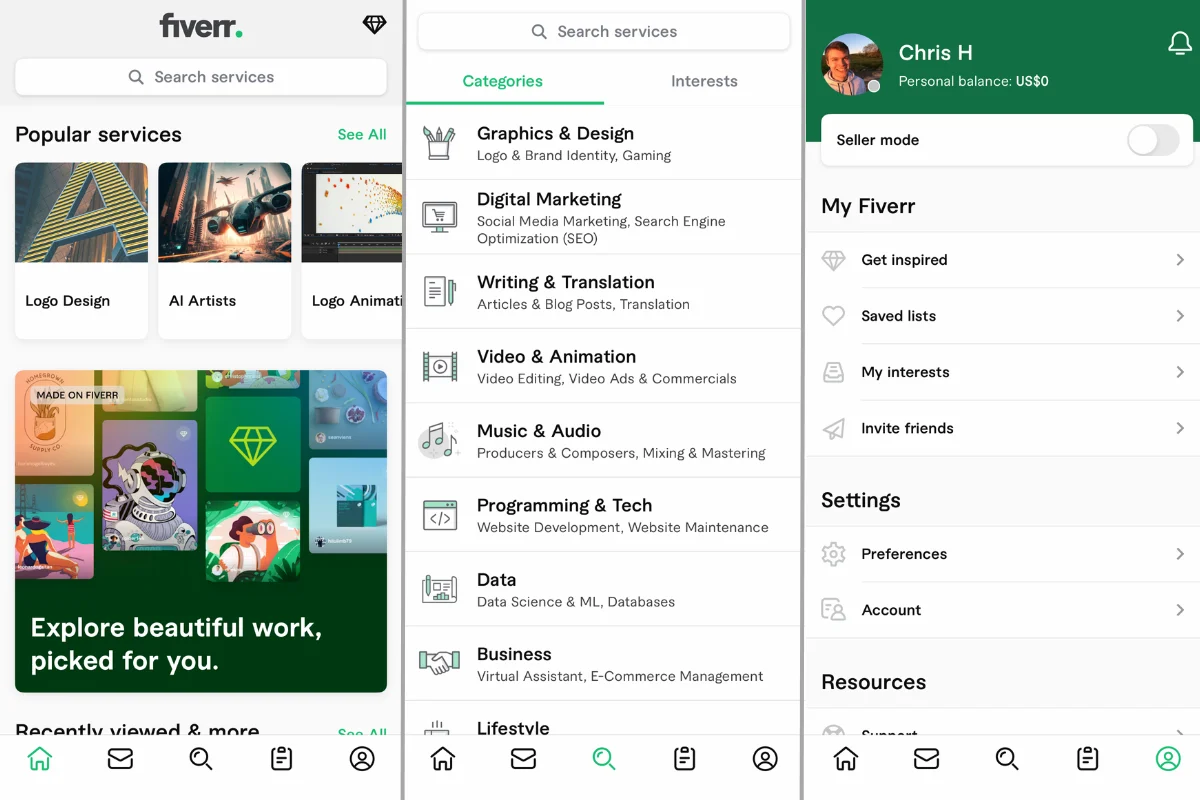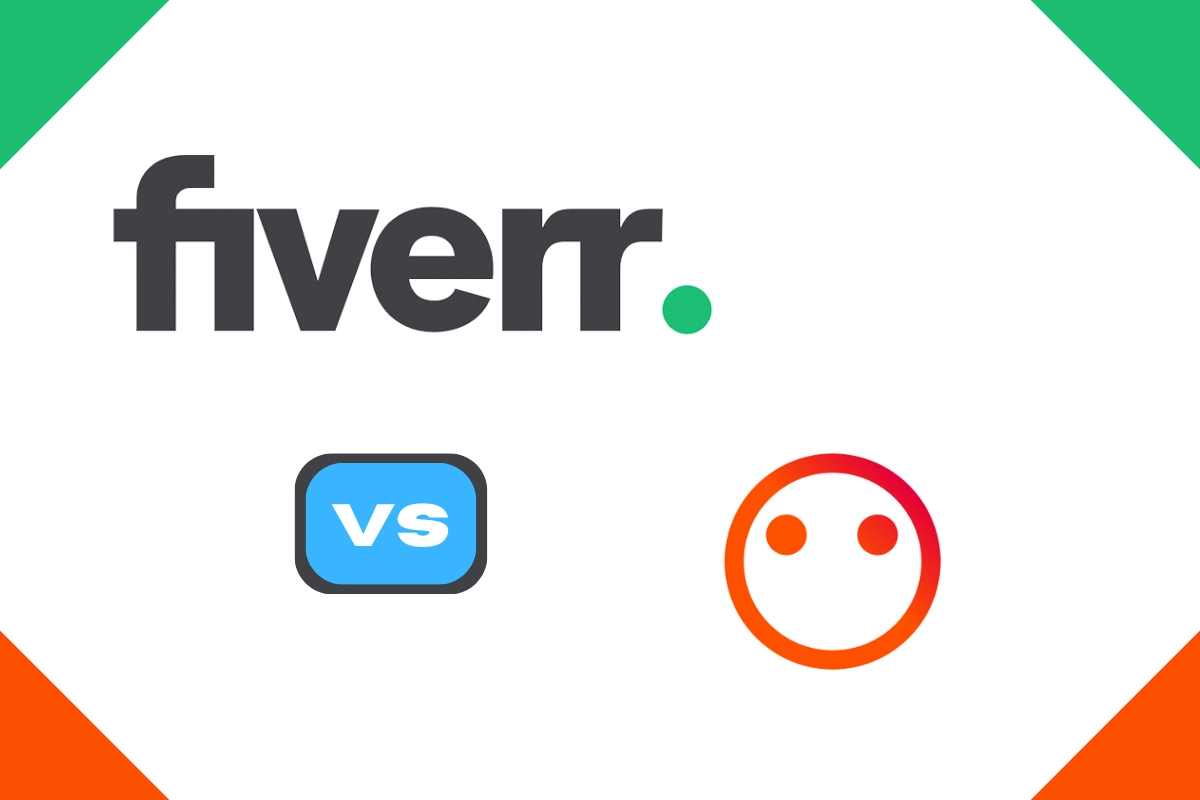There are lots of online freelance marketplaces offering opportunities across all fields and niches. Fiverr and PeoplePerHour are two of the most popular. But if you’re at the beginning of your freelancing career, which one should you pick?
In this article, I look at the main differences between Fiverr and PeoplePerHour when it comes to pricing, quality of work, fees, and ease of use to help you decide which one suits you best.
Note: PeoplePerHour is primarily popular in the UK, so a lot of the pricing on their website is in GBP. I’ll reflect that in this article, but there are some cases where the website has provided information in dollars and euros.
Fiverr vs PeoplePerHour Summary
| Feature | Fiverr | PeoplePerHour |
|---|---|---|
| How It Works | Buyers browse sellers’ gigs | Buyers can browse freelancers or post jobs |
| Pricing | 20% fee for sellers, 5.5% fee for buyers | 3.5% – 20% for sellers, 10% + £0.60 for buyers |
| Account Options | Free for buyers and sellers | Free for buyers and sellers |
| Work Quality | Varies a lot, often depending on seller level | It can vary a lot |
| Beginner Friendliness | Ideal starting point for beginners | Fairly beginner friendly, good option for UK freelancers |
What Is Fiverr?
Fiverr is one of the most popular freelancing marketplaces on the internet, and it was founded in 2010. Anyone can set up an account on Fiverr and start monetizing the service or skill they have to offer.
There are more than 500 different categories of jobs to choose from. So, if you’re a buyer, you’ll be able to find someone perfect for your project, no matter what it is. And if you’re a seller, there are always clients interested in the service you’re offering!

You can create up to seven gigs and set your own fee for each gig when you first start. The more gigs you sell on Fiverr, the more the platform rewards you with exposure. The more clients you work with, the more your earning capacity increases.
How Fiverr Works
Fiverr’s process is heavily focused on clients looking for freelancers to hire, rather than freelancers looking for jobs. This is in contrast to platforms like Freelancer or Upwork, where the focus is largely on clients posting jobs for freelancers to bid on.
You create gigs as a seller on Fiverr, and buyers can filter through gigs when searching for a given service. The platform occasionally matches buyers and sellers automatically, but I’ve found this to rarely happen and in my experience, it’s rarely led to a collaboration with a buyer (this replaced the old Buyer Requests function).
What Is PeoplePerHour?
PeoplePerHour is another popular freelance marketplace, founded in the UK in 2007. It connects clients with freelancers around the world, by allowing them to easily browse freelancer profiles and portfolios.

PeoplePerHour’s main distinguishing feature is that it is more location-specific than other freelance marketplaces. Many of the clients are seeking to hire freelancers from their local area, which can be helpful for some projects and may lead to longer-term working relationships.
How PeoplePerHour Works
PeoplePerHour gives you two options for finding freelancers when you’re a buyer on the platform. You can browse offers or you can create job posts. The former is a bit like Fiverr’s gig system, while the latter is more like systems on other platforms like Upwork and Freelancer, as I mentioned above.
Fiverr vs PeoplePerHour: Setting Prices
Fiverr
On Fiverr, you can charge a minimum of $5 (hence the name of the website) for a single gig, up to a maximum price of $20,000 for custom offers (this reaches $50,000 when you’re a Pro seller). Within that price range, you’re bound to find different types of work, with varying degrees of quality.
PeoplePerHour
On PeoplePerHour, you don’t need to advertise your services like you do on Fiverr. While you can do that, you can also apply for projects put on the site by buyers. The minimum price for a project is $10.
On paper, Fiverr may look like the cheaper option for clients. But it’s also important to remember that you get what you pay for, and the lowest-paid work can lack quality. While there are lots of top-quality freelancers on both platforms, there are also some that aren’t quite so good.
Verdict: Tie
Fiverr vs PeoplePerHour: Quality Of Work
Fiverr
Anyone who has a computer and a skill or service to offer can use Fiverr. Given the volume of freelancers on the platform, Fiverr doesn’t extensively evaluate every person that creates an account. This means there are a lot of poor-quality freelancers on the platform.
Fiverr has tried to address this issue with its levelling system. From Level 1 Sellers up to Fiverr Pros, this system is designed to separate the best from the rest.
Fiverr Pro (formerly Business) is a sub-section of Fiverr that consists of freelancers that Fiverr’s team has personally checked. So, if you want to make sure you’re getting quality work on Fiverr, it’s best to take the seller’s level into account. However, the more experienced the seller is, the higher their prices usually are.
PeoplePerHour
It’s not as easy to get accepted to work on PeoplePerHour. Unlike Fiverr, PeoplePerHour requires all freelancers to apply to be able to work on the platform. So, you’re more likely to find people with real, verified skills on PeoplePerHour, which increases the chances of getting better quality work. However, this also means you might have to pay more money for the same job.
The extensiveness of PeoplePerHour’s application verification process isn’t well defined though. So there are definitely still some quality issues. But that’s true of all freelance marketplaces!
Verdict: Tie
Fiverr vs PeoplePerHour: Fees
Fiverr
Fiverr’s fee structure for freelancers is very simple to understand. Regardless of what services you’re offering or your seller level, Fiverr takes a flat fee of 20% of the gig price. So, if you charge $100 for a gig, on completion you receive $80, while Fiverr takes $20.
The website also collects fees from buyers. These vary depending on the price of the gig you’re ordering. The rate is 5.5% of the order price, plus $2.50 if the order is less than $75 (as of June 2023). You can check out how much you’ll earn as a freelancer on the platform or how much you’ll need to pay for services using our Fiverr fees calculator.
PeoplePerHour
In December of 2019, PeoplePerHour announced an update to their fee structure (which they updated again in 2021), based on the lifetime earnings of a freelancer:
- For a freelancer with a lifetime billing below £250 ($350/€300), PeoplePerHour charges a service fee of 20%
- For those with lifetime earnings between £250 ($350/€300) and £5,000 ($7,000/€6,000), the platform charges a 7.5% service fee
- For freelancers with over £5,000 ($7,000/€6,000) earnings in total, PeoplePerHour charges a 3.5% service fee
This structure incentivizes freelancers to work long-term on PeoplePerHour. The more you make, the lower the fees need to pay. The fees are a bit more complex for buyers, depending on the payment method you use and whether or not you upgrade your project in some way. You can find a full list of buyer fees here. But they’re generally 10% of the order price plus £0.60.
Verdict: PeoplePerHour for sellers, Fiverr for buyers
Fiverr vs PeoplePerHour: Setting Up An Account
Fiverr
Setting up an account on Fiverr is quick, easy, and completely free. After filling out some personal information, you can start creating gigs. Marketing yourself is a huge part of freelancing. So, you must give it your all when presenting and describing your services to potential clients! You can create an overall Fiverr profile, and individual descriptions for each gig you offer.
Creating gigs starts with choosing a title that follows the expression “I will…” For example, “I will write financial blog posts for you.” After that, you choose how much you want to charge for what you’re offering and you’re ready to start freelancing on Fiverr!
Note: For more specific tips, check out our article on creating a good Fiverr gig.
PeoplePerHour
Creating an account on PeoplePerHour is more time-consuming and complicated than on Fiverr. PeoplePerHour requires a lot more information from you as a freelancer. They want to know about you, your skills, your certifications, and what you’re offering. They’ll also want you to link to some personal profiles, a portfolio, and references if you have any.
After filling in these details, PeoplePerHour evaluates your profile to decide whether to approve your application. You can either wait up to 7 working days for approval or choose a 24-hour option that costs £10. Once you’re approved, there’s a 3-month qualification period.
During this time, you must complete two projects resulting in a 4-star rating to be able to keep working on the platform. This might make it harder for beginner freelancers to gain traction on PeoplePerHour, but it helps the platform maintain relatively high standards.
Note: I have seen at least one forum thread on freelancers being asked to pay as a result of not completing enough jobs. I can’t personally verify whether this is still something that can happen, but I felt it was worth mentioning here!
Verdict: Fiverr
Fiverr vs PeoplePerHour: Ease Of Use
Fiverr
Fiverr is a very intuitive platform. If you’re looking to hire a freelancer for a specific project, you simply search the relevant category and choose the freelancer who best suits your needs. If you’re unsure or want to clarify anything, you can message the freelancer to discuss the project in more detail (I actually recommend doing this instead of just ordering a gig straight away).
Fiverr also has a very user-friendly app that allows you to manage your work, wherever and whenever you want to. The app works well across all types of devices.

PeoplePerHour
Like Fiverr, PeoplePerHour allows clients to search for potential freelancers by category. While there are fewer categories and filter options than on Fiverr, it’s also possible to search for freelancers by location. PeoplePerHour also has a mobile app that gives users access to the major functions of the website.
Verdict: Tie
Fiverr vs PeoplePerHour: Dispute Resolution
Fiverr
Fiverr encourages users to resolve disputes (like order cancellations) using the Resolution Centre, rather than involving a formal dispute resolution process manually facilitated by the platform. The risk of a dispute between the parties is lower because of the way the purchasing process is designed.
Buyers and sellers can follow the progress of a gig, request updates, and cancel requests. This means you’re unlikely to face any surprises as either the buyer or the seller. The seller is always allowed to respond before the request is approved or cancelled.
PeoplePerHour
PeoplePerHour’s dispute resolution process is the complete opposite. When a client raises a concern, an arbitration process automatically starts. PeoplePerHour simply looks at what happened on the website between the buyer and the seller, and they make the final decision. Note that there is a dispute fee if you’re a freelancer raising the dispute.
Verdict: Tie
Fiverr vs PeoplePerHour: Which Should You Use?
Considering the features we’ve explored, Fiverr seems to be the best option for freelancers because:
- You have full control over your prices and the way your gigs look
- It’s easy to build some authority on the platform if you provide high-quality work
- It’s easy to use on all devices
- Setting up an account is straightforward
PeoplePerHour is a more selective freelancer market. While it has an advantage over Fiverr when it comes to fees and the ability to work with local freelancers, Fiverr offers more benefits overall. If you’re a buyer, I recommend trying both to see which one provides the best results for your projects.
And when you’re first starting out as a freelancer, I recommend you explore both marketplaces to decide which one is best for you and your circumstances.
Raquel is a freelance writer with a knack for technology and a passion for science. She draws on her own years of freelance writing experience to craft articles for Freelance Ready on topics including freelancing on Fiverr and the popular blogging platform Medium.com. Learn more about Raquel here.
Freelance Ready is reader-supported. That means some links on this website are affiliate links. If you sign up or make a purchase through these links, we may earn a commission.


